Sheep and lamb processing: assessment
Research investigating the opportunities and challenges industry faces in retaining and increasing sheep and lamb processing in Scotland.
3 The market for Scottish sheepmeat
3.1 Introduction
3.1 Of sheepmeat processed in Scotland, most is destined for market outlets outwith Scotland (Table 2). For example, although subject to some year-on-year fluctuations, for 2017 (the most recent data currently available) the rest of the UK accounted for over half of sales by value, exports beyond the UK for over a quarter and Scotland less than a fifth. This reliance on non-Scottish outlets reflects the relatively small domestic market, which is constrained by both the absolute size of the human population and by low per capita consumption of lamb (discussed further below).
Table 2 Estimated market destinations (by value) for Scottish abattoir sheepmeat
| Scotland | Rest of UK | Beyond UK | ||||
|---|---|---|---|---|---|---|
| £m | % | £m | % | £m | % | |
| 2013 | 14.5 | 10.0 | 96 | 65.5 | 35.5 | 24.5 |
| 2014 | 18.0 | 12.0 | 94.0 | 63.0 | 37.0 | 25.0 |
| 2015 | 17.0 | 12.5 | 84.5 | 62.0 | 34.5 | 25.5 |
| 2016 | 10.5 | 9.0 | 75.0 | 65.0 | 30.5 | 26.0 |
| 2017 | 23.0 | 18.0 | 74.0 | 56.0 | 34.0 | 26.0 |
Source: QMS (various) – The Scottish Red Meat Industry Profile
3.2 It is important to recognise that sheepmeat is not a homogenous product, and that utilising the whole carcase ("carcase balance") typically requires serving multiple markets with different products. For example, UK consumers purchasing through supermarkets have a preference for legs and chops. Moreover, variable demand and supply across the year means that the UK can be a net exporter at some times and a net exporter at others.
3.3 The configuration of specific supply-chains is complex and varies across different processors, but supermarkets dominate Scottish market outlets, with retail wholesalers accounting for almost all other sales (Table 3). Within this, different Scottish processors have relationships with different supermarkets as detailed in section 2.4.2.
Table 3 Estimated market outlet shares Scottish abattoir sheepmeat
| Multiple retailers | Independent retailers | Retail wholesalers | Food manufacturers | Food Service/Catering | |
|---|---|---|---|---|---|
| 2013 | 62.7% | 0.7% | 29.9% | 3.3% | 3.3% |
| 2014 | 61.3% | 0.7% | 30.7% | 3.6% | 3.6% |
| 2015 | 63.6% | 1.1% | 29.0% | 3.0% | 3.3% |
| 2016 | 60.0% | 2.0% | 32.0% | 3.0% | 3.0% |
| 2017 | 62.9% | 2.0% | 34.9% | 0.1% | 0.1% |
Data Source: Based on QMS (various) – The Scottish Red Meat Industry Profile. Adjusted in consultation with QMS to account for methodological changes
3.4 The long-term trend in sheepmeat consumption within Scotland and the UK is downwards, reflecting changing consumer preferences. For example, a shift towards poultry and ready-to-eat meals, but also reductions in overall meat demand and increasing interest in food provenance. These changes reflect a variety of factors, including changing demographics and incomes but also the evolution of relative prices for different meats.
3.5 For example, lamb is typically more popular with older consumers but also certain ethnic groups, and demand is often uneven through the year due to the timing of (religious) festivals. Importantly, these factors vary geographically, reflecting regional (and international) differences in demographics, cultures and incomes. The following sections explore these factors for different markets.
3.2 The home (Scottish) market
3.6 Relative to other parts of the UK, Scottish consumers eat considerably less lamb per head than consumers elsewhere (Figure 9): Scots have traditionally eaten more beef. Combined with a small human population, this constrains overall domestic demand and explains why markets beyond Scotland are important.
Figure 9 Annual average per capita purchases (kg) of lamb[29] by GB region - 2017
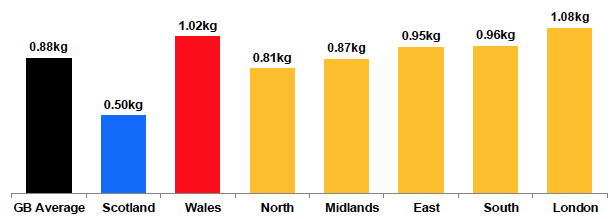
3.7 Perhaps intuitively, Scotch Lamb has a higher penetration in Scotland than the rest of GB. However, lamb with Scottish labelling still only accounts for 22% of overall sales for home cooking in Scotland compared with 48% being sourced from the Rest of the UK and 17% from New Zealand.
3.8 Sales of mutton within Scotland are negligible, reflecting both the demise of traditional mutton consumers but also the relatively low density of ethnic groups with greater preferences for mutton. At the last census, just 4% of the Scottish population defined themselves[30] as Asian, African, Caribbean or Black compared to 12% in England and Wales[31]. Although halal sheepmeat is available in Scotland, most Scottish cull sheep are slaughtered closer to more densely concentrated ethnic populations in England (but some of this product may subsequently be moved back to Scotland).
3.9 The dominance of supermarket and other retailers in domestic sales implies that relatively little sheepmeat from Scottish abattoirs is destined for food processing or catering purposes. Unfortunately, data on consumption of sheepmeat in meals prepared outwith the home is less readily available than for home cooking purposes – typically, different meats are not reported separately.
3.10 If per capita consumption patterns follow those for home cooking, processed and food-service demand may add perhaps a further 0.8kg to 1.1kg per head to give total per capita lamb consumption in Scotland of 1.3kg to 1.6kg. Aggregated across the Scottish population, this implies total domestic demand of about 6,800 tonnes to 8,500 tonnes of consumed meat, or approximately 9,000 to 11,350 tonnes CWE.[32]
3.11 Estimated lamb consumption in Scotland is thus higher than the volume of sheepmeat produced in Scotland and sold in Scotland, implying some scope to increase home consumption of Scottish-produced sheepmeat. However, evidence suggests that food processing and food-service are highly price-sensitive and, with a few exceptions for high-end products, country of origin is relatively unimportant. This implies that higher returns may be more easily gained by targeting other markets.
3.12 Similarly, the research found that overall food-service lamb consumption in the public sector is low, at perhaps less than 50 tonnes per year. Hence, whilst promotion of domestically-sourced supplies within public sector procurement processes is often portrayed as important (indeed, recent efforts have boosted the share of Scottish lamb used within the Scottish public sector), other markets offer greater scope for increasing sales more dramatically.
3.3 The British market
3.13 At the UK level, total sheepmeat available for consumption is estimated to be around 300,000 tonnes CWE or around 225,000 tonnes as consumed.[33] Of this, over three-fifths is sourced from the UK but New Zealand accounts for over a fifth whilst less than 2% is of explicit Scottish origin – i.e. branded as Scotch Lamb (Figure 10).
Figure 10 British lamb market by provenance

3.14 Within this, there is some demographic variation in consumption patterns. For example, per capita consumption is notably higher for older groups (Figure 11) and some ethnic groups (Figure 12). The latter highlights the importance of the growing halal market.
Figure 11 Average per capita lamb consumption[34] (kg/year) by life stage
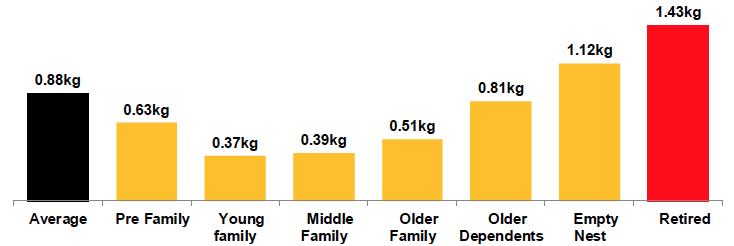
Figure 12 Average per capita lamb consumption[35] (kg/year) by ethnicity
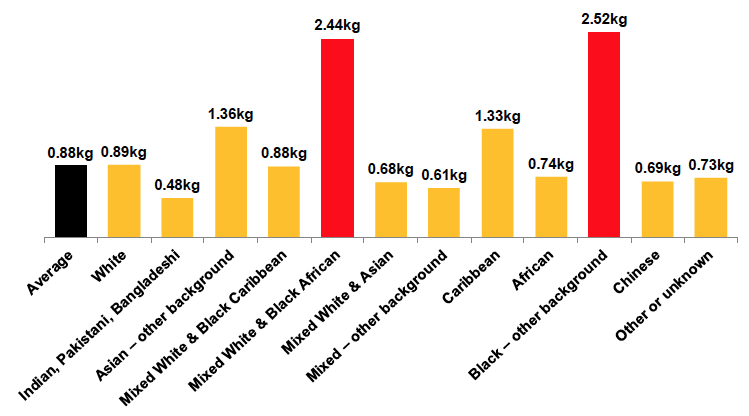
3.15 Moreover, aggregate consumption figures mask the specific cuts of meat that are being consumed – which matters to processors having to balance overall utilisation of carcasses and find outlets for less popular cuts. Figure 13 shows the relative proportions (by value) of different cuts of fresh and frozen lamb purchased for home consumption. This reiterates that frozen lamb sales are minimal, with a preference for fresh cuts. Over a third of the GB lamb purchases for home consumption were for legs (26% in Scotland) with lamb chops (16%) and lamb steaks the next most common lamb purchase. In Scotland lamb chops (22%) and lamb steaks (20%) were a larger share of the market than for GB as a whole.
Figure 13 GB vs. Scotland consumption shares of fresh & frozen lamb cuts
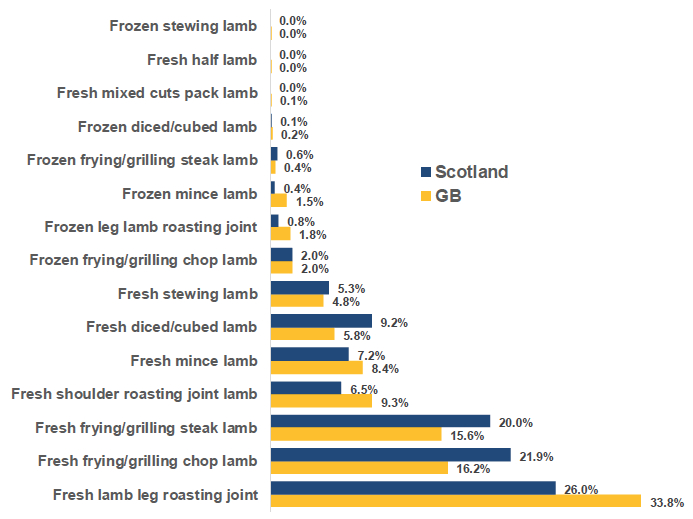
3.16 Further analysis reveals that whilst Scotch Lamb accounts for 30% of Scottish household purchases of lamb chops/steaks it only accounts for 20% of fresh lamb leg purchases, with legs from the rest of the UK accounting for 48% of purchases and New Zealand legs (24%) having a larger share of the Scottish market than 'Scotch' (see Table 4). Furthermore the data illustrates the weak penetration that 'Scotch Lamb' has in the wider GB market.
Table 4 Origin of key lamb purchases in Scotland and GB, 2017
| Origin of Product | Fresh frying/grilling chop or steak | Fresh leg or shoulder roasting joint | ||
|---|---|---|---|---|
| Scottish Market | GB Market | Scottish Market | GB Market | |
| 'Scotch' | 30% | 3% | 20% | 1% |
| Rest of UK | 50% | 72% | 48% | 63% |
| New Zealand | 15% | 20% | 24% | 26% |
| Other origin | 6% | 4% | 8% | 9% |
Source: Own elaboration based on Kantar Worldpanel data
3.17 Figure 14 reveals that demand for lamb varies throughout the year, with a significant spike at Easter and a smaller spike in the New Year (the latter is much more pronounced for poultry and other meat products). Although not visible in the aggregate data, spikes also occur in the growing halal market segment to correspond with festivals marking the end of Ramadan (Eid al-Fitr) and during Eid al-Adha, with the timing of both changing year-on-year. Figure 14 also highlights the relatively small share of overall meat demand (c.5%) accounted for by lamb.
Figure 14 GB Meat expenditure shares
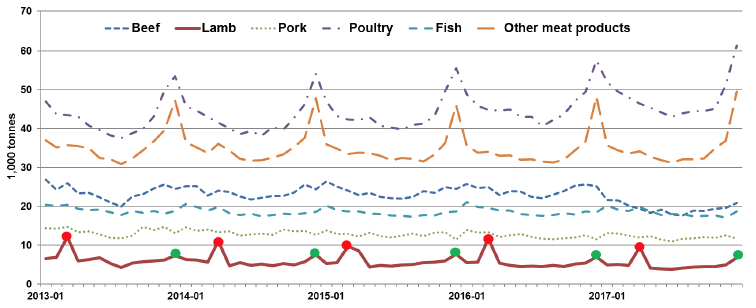
3.18 As with Scotland, figures on UK consumption via processed products or food-service are not readily available. However, if c.225,000t are consumed overall this implies total per capita consumption of around 3.3kg, and hence processing and food-service will account for approximately 2.4kg per head (approximately 3.2kg CWE).
Figure 15 Retail sales of 2kg legs of lamb in 4 week periods, 2018
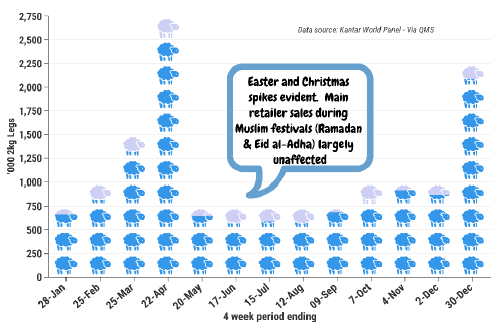
3.19 Whilst Figure 14 demonstrates the seasonal peaks of sheepmeat demand it does not illustrate the importance that demand for legs of lamb play in these spikes. Estimates for the number of legs of lamb sold through supermarkets in a four week period (Figure 15) reveals the significant demand for legs of lamb during the Christian festival spikes of Easter and Christmas. This leads to a requirement for processors to find outlets for the remainder of carcase (carcase balancing) or for legs to be sourced from imports. It should be noted that Figure 15 fails to show increased lamb demand during Muslim festivals due to purchases generally being made through different retail outlets and preference for different cuts of lamb and mutton.
3.20 The influence of prices and incomes on consumption can be estimated through elasticities, a measure of the responsiveness of demand to changes in prices or incomes. Analysis of Kantar World Panel data (see Appendix 3 for full table of elasticities) highlights that lamb demand is particularly sensitive to changes in its own price, much more so than other meats. For example:
- Lamb is the most sensitive meat to its own price: a 10% rise in the price of beef would cause demand for beef to contract by 1.7%, but a 10% rise in the price of lamb would cause a 34.7% fall in lamb demand.
- Lamb demand is impacted by price of other meats: a 10% increase (fall) in beef prices would lead to 21% more (less) lamb consumption whereas a 10% increase (fall) in the price of lamb only increases (decreases) beef demand by 6%.
- Demand for lamb is more sensitive to household incomes than other meats: a 10% increase in income would (on average) lead to 15.2% more expenditure on lamb, whereas a 10% income rise would only increase expenditure on pork by 4.5%.
3.21 These elasticities suggest that price promotions and/or longer-term price reductions could stimulate demand, although it should be noted that higher lamb demand would lead to lower demand for other meats, including beef. As lamb demand is also responsive to income changes, it implies that rising incomes for Muslim consumers may contribute to growth in the halal market segment.[36]
3.4 The Global Market
3.22 The vast majority of the UK's sheepmeat exports have consistently been to the EU (Figure 16), although there have been some exports to non-EU countries.
Figure 16 Estimated UK Sheepmeat exports to EU and non-EU countries
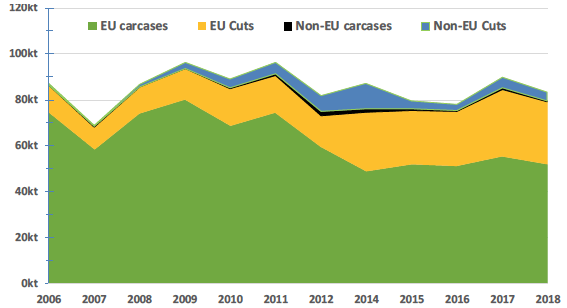
Source: AHDB UK sheep meat trade[37]
3.23 Figure 17 shows the UK's main sheepmeat trade partners by volume of product whilst Figure 18 shows the value of that product[38] (see Appendix 5 for underlying data). In 2018, six countries (France, Germany, Ireland, Italy, Belgium and the Netherlands) accounted for 97% of the UK's exports destined for the EU and 90% of the UK's minimal sheepmeat imports from the EU. In 2018 non-EU countries (RoW[39]) countries (New Zealand, Australia, Iceland and Hong Kong) accounted for 98% of the UK's imports from non-EU trade partners and 68% of UK exports beyond the EU.
3.24 Most of the UK's sheepmeat imports are tariff free and Figure 17 and 18 reiterate the reliance on New Zealand and Australia for sheepmeat imports. This is reflective of the generous tariff free quota (maximum volume of tariff free market access) bilaterally afforded to these countries.
3.25 The main RoW export market is Hong Kong that is dwarfed by the UK's EU export markets. In 2018 the principle EU markets were France, Germany and Belgium. The UK imports a small amount of sheepmeat from the EU, principally the Republic of Ireland, although that is more than balanced-out by UK exports there.
Figure 17 UK sheep meat trade (2018) main import and export markets by mass of product
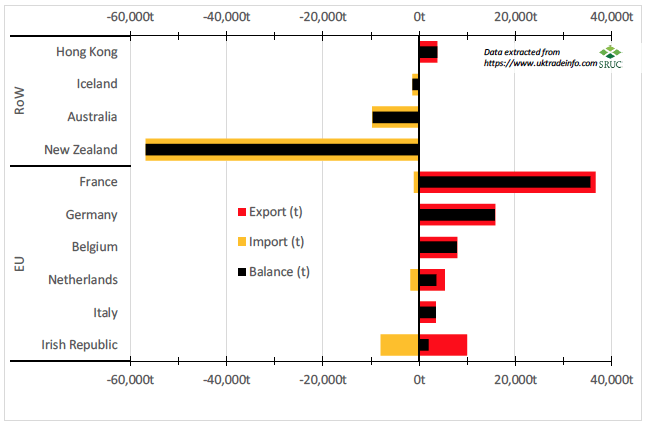
Figure 18 UK sheep meat trade (2018) main import and export markets by product value
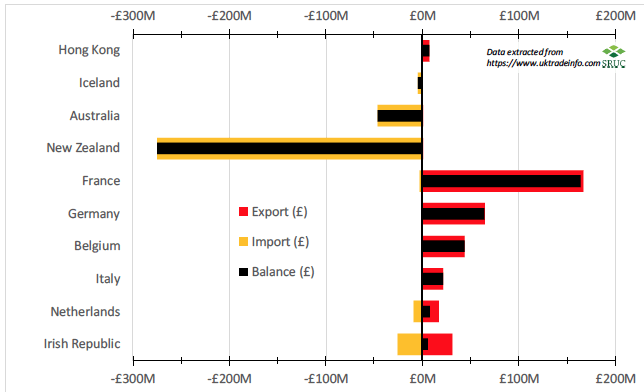
3.26 Within the UK's sheepmeat trade, EU trade is approximately two-thirds carcases versus one-third cuts, with the latter typically comprising items required to balance UK preferences for (especially) legs. Exports beyond the EU are almost entirely of cuts, again often as a result of carcass-balancing but typically achieving a relatively low price.
3.27 The trade data illustrates a very important point about the balance of sheepmeat product imported to the UK and what we export. It is clear that imports are made up of legs of lambs and other processed cuts, whilst exports are significantly dominated by half or whole carcases of lamb and mutton.
3.28 Figure 19 shows imports and exports (and the net balance – black bar) of different sheepmeat products (see Appendix 5 for underlying data). The red bars indicate how the UK's EU exports are dominated by relatively unprocessed fresh/chilled lamb carcases and half carcases and fresh mutton carcases and half carcases. This contrasts with UK imports which are largely made up of fresh and frozen legs of lamb and other processed cuts.
Figure 19 UK sheepmeat trade (2018) by product type and mass
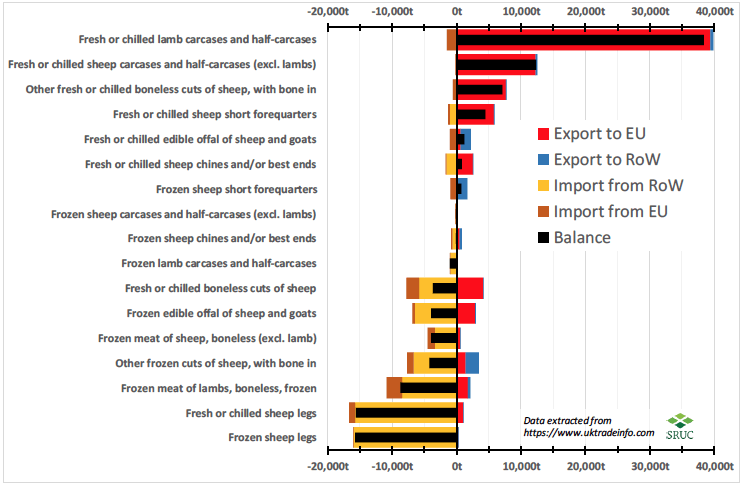
Figure 20 UK sheepmeat trade (2018) by product type and value
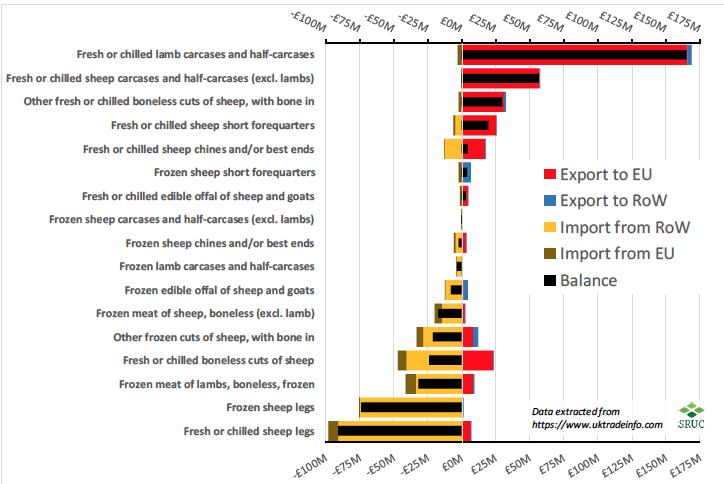
3.29 Despite the mass and value of the UK's sheepmeat imports and exports being very similar – it is not as straight forward as some may think for the UK to satiate its own internal consumer demand. A simple illustration can be made for legs of lamb/mutton. Figure 21 shows the seasonal peaks (Easter, Ramadan, Eid al-Adha and Christmas) of demand for cut legs of lamb (both imports and exports) of cut legs of lamb/mutton. Whilst these follow similar patterns export volumes (1.3kt) are a fraction of imports (33kt) in 2018.
Figure 21 UK trade in legs of lamb/mutton 2018
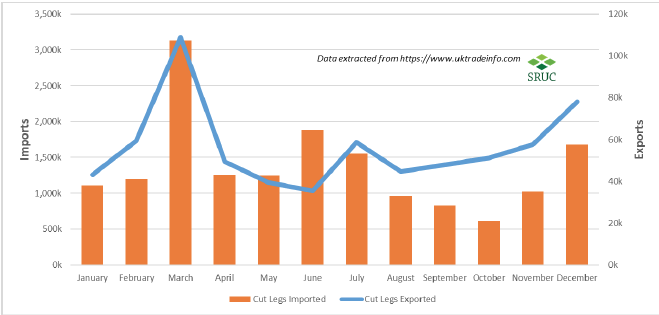
3.30 Using a 2.5kg average weight for a leg of lamb and a 20kg average carcase (2 legs) weight it was estimated that the UK imported in the region of 13.3 million legs of lamb/mutton (mainly processed cuts) and exported in the region of 6.3 million legs of lamb/mutton (mainly on carcases) – a net import requirement of around 7 million legs or 3.5 million sheep. It is difficult to see how this demand can be satiated from the internal market given the seasonality of demand compared to production and the significant issue of what processors would do with the remainder of the carcase (carcase balancing).
3.31 The key import and export trade relations, with details of the type of lamb products imported and exported are summarised in Figure 22, highlighting that what the UK exports and imports are not equivalent products.
Figure 22 UK sheepmeat trade summary
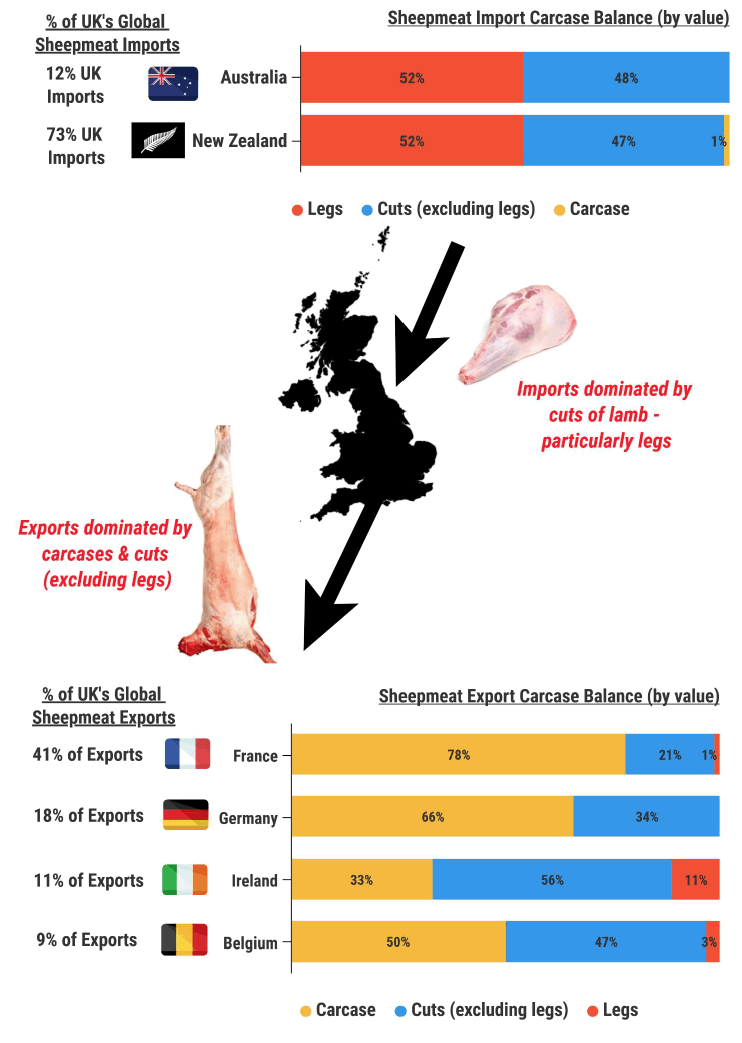
3.32 As in the UK, sheepmeat accounts for a relatively low share of overall global meat consumption and this is forecast to remain the case even as overall global demand increases (Figure 23).
Figure 23 Past and Forecast global meat demand
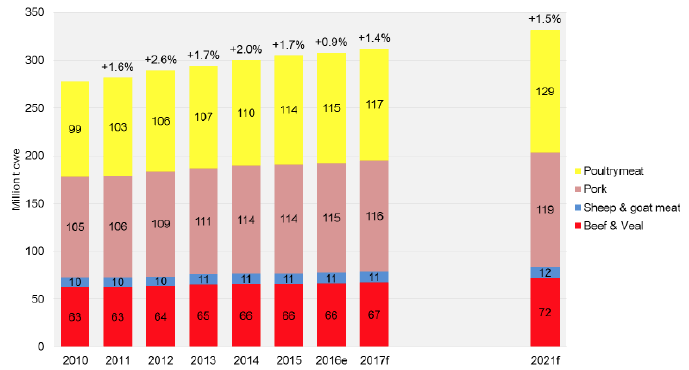
(Source: Brown, 2017)
3.33 Moreover, the modest increase in overall sheepmeat consumption is unevenly distributed (Figure 24), with demand effectively flat in Europe and the Americas (which suggests little to be gained from any future trade deal with the USA) but increasing in Asia, Africa and the Middle East (highlighting, again, the importance of the growing halal market segment).
Figure 24 Past and Forecast Global Sheepmeat Demand
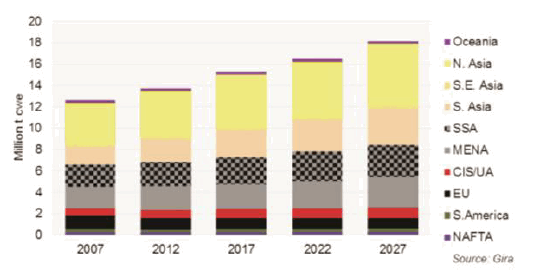
Source: Gira reported in LMC (2018)
3.34 Some parts of the EU are already exporting to these new markets. For example, Spain to the Middle East and North Africa (MENA). However, Australia and New Zealand also compete for these markets and almost totally dominate Asian markets (e.g. 32% and 67% respectively of Chinese imports of sheepmeat in 2017) meaning that there will be stiff competition for any Scottish processors seeking to enter them.
3.5 Implications of Brexit
3.35 Both directly through sales of whole carcasses and indirectly through the facilitation of carcass-balancing, the UK's exports of sheepmeat contribute to maintaining domestic prices. The heavy reliance on wider UK markets, and challenges inherent in expanding exports to the rest of the world, mean that Scottish sheep farmers and processors are significantly exposed to Brexit-related risks of trade disruption. These may take the form of import tariffs and/or non-tariff barriers imposed by the EU, and could severely depress domestic prices and threaten viability of the entire supply-chain.
3.36 The UK's decision to withdraw from the EU has significant risks for the UK sheep farming and processing sectors. Whilst future supplies may be affected by long term changes in agricultural support, the most immediate risk comes from EU tariff barriers if there is a no-deal Brexit. In such an instance the UK would leave the single market and customs union and would immediately revert to World Trade Organisation's Most Favoured Nation status.
3.37 EU sheepmeat tariffs work in two ways. Firstly, there is an ad valorem[40] tariff of 12.8% of product value. In addition, there is a fixed rate tariff that is expressed in Euros per volume of product – which range from €1.199 per Kg for sheep short forequarters to €3.118 per Kg for boneless cuts of sheep. Table 5 provides details of the full list of EU tariffs for each sheepmeat product. In addition it provides details of UK's 2018 EU export volume and value with an illustrative effective overall tariff rate[41]. It finally illustrates what the effective product price (and percentage reduction) would need to be in the UK for product to be delivered into EU at the average 2018 UK export price under a no-deal Brexit scenario where full EU tariffs were imposed.
3.38 Exchange rates effects can play a significant role in changing 'effective tariff rates' and no account is taken for potential changes in demand for UK lamb. Therefore, whilst this is not a forecast of future trade costs with the EU under a no-deal Brexit it illustrates the challenges that EU tariffs would bring to the Scottish (and wider UK) sheep export sector. Based on 2018 trade data:
- Overall the effective tariffs on sheepmeat would have been 48% of export value, ranging from 0% on offal to 68% for boneless cuts of mutton (note that tariffs are generally higher on more processed products)
- On £356m of exports the tariff bill would have amounted to £171m.
- Overall if UK exports were to face tariffs and product was to be landed in the EU at the same delivered price as 2018 there would have needed to be a 51% price reduction in the UK for these export products (ranging from -67% for boneless mutton, -52% for fresh lamb carcases / half carcases, to -28% for frozen mutton carcases/half carcases).
3.39 The effect of these tariffs (should a no-deal Brexit occur) are plain to see – with ramifications for processors, farmers and crofters with a reliance on the EU market. Sheep prices in the UK would adjust downwards, with potentially a significant glut of lamb and mutton in the UK (some live export – to Ireland – may start-up as live animals have lower tariff rates), although reduced prices coupled with exchange rate effects may mitigate some of the negative tariff impacts. If consumer prices were to fall as a result then the UK may look unattractive to New Zealand and Australian exporters (this is why New Zealand and Australia do not agree with the EU/UK split of tariff rate quotas for sheepmeat as they know the EU market will look more attractive under a no deal Brexit). However, the UK consumer preference for legs of lamb would mean that a minimum of 7m legs of lamb would still need to be procured
Table 5 UK 2018 Sheepmeat Exports to EU and cost and impact of tariff barriers
| 2018 Exchange rate €1=£0.884564352056612 | 2018 Exports | EU Tariff | If to be landed in EU at pre-tariff price | |||||||
|---|---|---|---|---|---|---|---|---|---|---|
| Code | Product | Value | Mass | Value/Kg | Ad Valorem | Fixed (€/100kg) | Tariff Cost | Effective Tariff | Price /Kg | Price Cut |
| All EU Exports | £356.39m | 81,231t | £4.39 | 12.8% | €174.71 | £171.15m | 48% | £2.14 | -51% | |
| Fresh or Chilled | ||||||||||
| 02041000 | Lamb carcases and half-carcases | £165.80m | 39,426t | £4.21 | 12.8% | €171.30 | £80.96m | 49% | £2.01 | -52% |
| 02042100 | Sheep carcases and half-carcases (excl. lambs) | £57.16m | 12,270t | £4.66 | 12.8% | €171.30 | £25.91m | 45% | £2.41 | -48% |
| 02042210 | Sheep short forequarters | £25.24m | 5,818t | £4.34 | 12.8% | €119.90 | £9.40m | 37% | £2.64 | -39% |
| 02042230 | Sheep chines and/or best ends | £17.41m | 2,534t | £6.87 | 12.8% | €188.50 | £6.45m | 37% | £4.20 | -39% |
| 02042250 | Sheep legs | £6.70m | 1,041t | £6.43 | 12.8% | €222.70 | £2.91m | 43% | £3.47 | -46% |
| 02042290 | Boneless cuts of sheep, with bone in (excl. carcases and half-carcases, short forequarters, chines and/or best ends, and legs) | £30.89m | 7,641t | £4.04 | 12.8% | €222.70 | £19.01m | 62% | £1.35 | -67% |
| 02042300 | Boneless cuts of sheep | £23.11m | 4,094t | £5.64 | 12.8% | €311.80 | £14.25m | 62% | £1.88 | -67% |
| 02068099 | Edible offal of sheep and goats | £4.40m | 2,946t | £1.49 | 0.0% | 0% | ||||
| Frozen | ||||||||||
| 02043000 | Lamb carcases and half-carcases | £0.04m | 12t | £3.19 | 12.8% | €128.80 | £0.02m | 48% | £1.54 | -52% |
| 02044100 | Sheep carcases and half-carcases (excl. lambs) | £0.10m | 18t | £5.39 | 12.8% | €90.20 | £0.03m | 28% | £3.87 | -28% |
| 02044210 | Sheep short forequarters | £0.75m | 192t | £3.89 | 12.8% | €90.20 | £0.25m | 33% | £2.55 | -35% |
| 02044230 | Sheep chines and/or best ends | £3.05m | 486t | £6.28 | 12.8% | €141.70 | £1.00m | 33% | £4.15 | -34% |
| 02044250 | Sheep legs | £0.99m | 243t | £4.09 | 12.8% | €167.50 | £0.49m | 49% | £1.95 | -52% |
| 02044290 | Cuts of sheep, with bone in (excl. carcases and half-carcases, short forequarters, chines and/or best ends, and legs | £8.18m | 1,412t | £5.80 | 12.8% | €167.50 | £3.14m | 38% | £3.46 | -40% |
| 02044310 | Meat of lambs, boneless, | £8.79m | 1,842t | £4.77 | 12.8% | €234.50 | £4.95m | 56% | £1.88 | -61% |
| 02044390 | Meat of sheep, boneless (excl. lamb) | £2.44m | 649t | £3.75 | 12.8% | €234.50 | £1.66m | 68% | £0.97 | -74% |
| 02069099 | Edible offal of sheep and goats | £1.35m | 606t | £2.22 | 0.0% | 0% | ||||
Trade Data extracted from https://www.uktradeinfo.com
Exchange rate ONS average for 2018 https://www.ons.gov.uk/economy/nationalaccounts/balanceofpayments/timeseries/thap/mret
Contact
Email: socialresearch@gov.scot
There is a problem
Thanks for your feedback